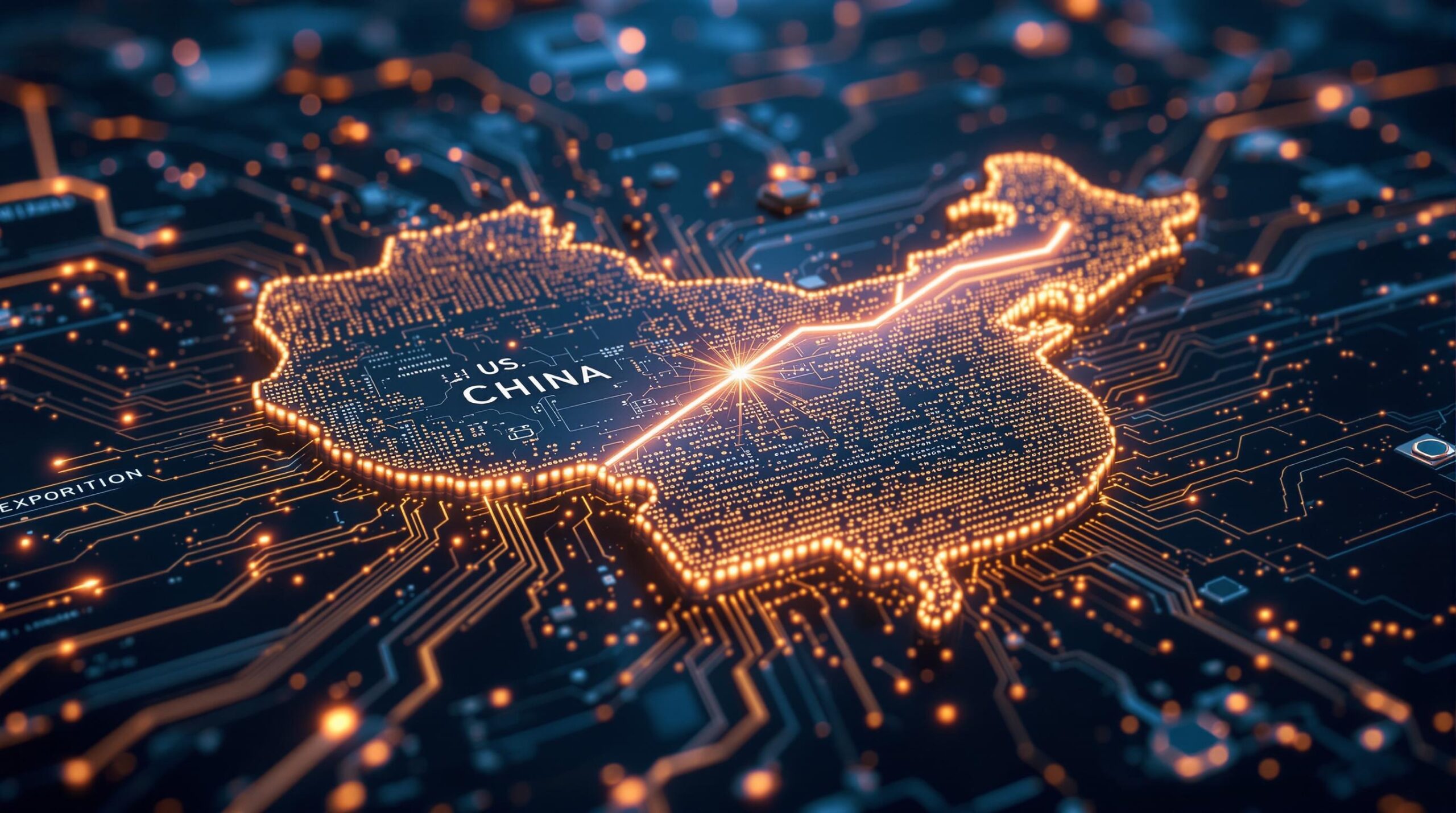BitcoinWorld

Unveiling Trump’s AI Chips Strategy: A Critical Look at US-China Export Controls
In the fast-evolving landscape of global technology, few areas hold as much strategic importance as artificial intelligence. For those deeply invested in the cryptocurrency space, understanding geopolitical shifts in tech policy is crucial, as they often ripple through global markets, influencing everything from investment trends to the stability of digital assets. The recent unveiling of the Trump administration’s AI Action Plan, with its ambitious goals for American AI leadership and its stern stance on controlling the flow of advanced AI chips to rivals like China, signals a significant development in this ongoing tech rivalry. But how will these bold intentions translate into concrete actions, and what does it mean for the delicate balance of innovation and national security?
The Grand Ambition: Securing AI Dominance Amidst the US China Tech War
The Trump administration’s AI Action Plan articulates a clear vision: to cement America’s position as the undisputed global leader in artificial intelligence. This ambition isn’t just about technological prowess; it’s deeply intertwined with national security and economic competitiveness. The plan emphasizes the United States’ current advantage in critical areas such as data center construction, computing hardware performance, and the development of cutting-edge AI models. It explicitly states, "America currently is the global leader on data center construction, computing hardware performance, and models. It is imperative that the United States leverage this advantage into an enduring global alliance, while preventing our adversaries from free-riding on our innovation and investment."
This statement encapsulates the core dilemma at the heart of the current US China tech war: how to foster an open, innovative environment that propels American industry forward, while simultaneously erecting barriers to prevent adversaries from exploiting these advancements. The tension between collaboration and containment is palpable, and the proposed solutions, while strong in rhetoric, appear to be still in their formative stages.
The plan highlights the strategic imperative of leveraging America’s existing strengths to build a lasting global alliance. This isn’t merely about sharing technology but about establishing a unified front against potential threats. The administration’s focus on preventing adversaries from "free-riding" on American innovation underscores a protective stance, aiming to safeguard intellectual property and technological advantages that have been cultivated through significant investment and research.
Achieving this delicate balance requires a multifaceted approach that extends beyond domestic policy. It necessitates intricate diplomatic engagement and a clear understanding of the global supply chains that underpin the AI ecosystem. The challenge lies in translating these broad strategic goals into actionable policies that are both effective and sustainable in the long run, without inadvertently stifling the very innovation they seek to protect.
Navigating the Labyrinth of AI Export Controls
A cornerstone of the Trump AI Action Plan is its emphasis on strengthening AI export controls, particularly concerning advanced AI chips. The plan speaks of implementing "creative approaches" to achieve this, followed by two key policy recommendations:
- Chip Location Verification: The first recommendation calls for government organizations, including the Department of Commerce and the National Security Council, to collaborate with the AI industry on developing robust chip location verification features. This suggests a move towards ensuring that advanced chips, once exported, do not end up in unauthorized hands or locations, particularly those of foreign adversaries. The technical complexity of implementing such features, however, is immense, requiring close cooperation between government regulators and private sector innovators who design and manufacture these highly sophisticated components.
- Enforcement of Component Sub-systems: The second recommendation focuses on establishing an effort to figure out enforcement for potential chip export restrictions. Crucially, it notes that while the U.S. and its allies currently impose export controls on major systems required for chip manufacturing, there isn’t a similar focus on many of the component sub-systems. This omission is a significant loophole that the administration aims to close. By targeting these smaller, yet critical, components, the administration hopes to create a more comprehensive and watertight system of control, preventing adversaries from reverse-engineering or assembling advanced AI capabilities from unrestricted parts. This shift in focus indicates a deeper understanding of the intricate supply chains that underpin the semiconductor industry.
The phrase "creative approaches" itself hints at the complexity and novelty of the challenges involved. Traditional export control mechanisms may not be sufficient for technologies as pervasive and rapidly evolving as AI. The dual-use nature of many AI technologies – capable of both civilian and military applications – further complicates enforcement. Any new framework would need to be agile enough to adapt to technological advancements while being robust enough to withstand circumvention efforts.
The Crucial Role of Global Alliances in AI Export Controls
Beyond domestic measures, the AI Action Plan underscores the critical need for the U.S. to find alignment with its global allies in this area. The administration recognizes that unilateral action, while impactful, can be circumvented if allies do not follow suit. The plan explicitly states, "America must impose strong export controls on sensitive technologies. We should encourage partners and allies to follow U.S. controls, and not backfill. If they do, America should use tools such as the Foreign Direct Product Rule and secondary tariffs to achieve greater international alignment."
This highlights a key challenge: diplomatic persuasion and, if necessary, economic leverage. The Foreign Direct Product Rule (FDPR) is a powerful tool that allows the U.S. to control foreign-produced items that are the direct product of certain U.S. technology or software, or produced by plants or major components thereof that are themselves the direct product of U.S. technology or software. Applying this rule broadly could significantly impact global supply chains, potentially forcing foreign companies to choose between doing business with the U.S. or with countries subject to these controls.
Secondary tariffs, another tool mentioned, would involve imposing duties on goods from countries that do not align with U.S. export controls, effectively penalizing them for "backfilling" the technology gap left by U.S. restrictions. While these tools offer leverage, their application carries significant geopolitical and economic risks, potentially alienating allies or disrupting global trade. The success of such a strategy hinges on careful diplomatic negotiation and a shared understanding of the strategic threat posed by unchecked AI proliferation.
The plan’s ambition to foster a global alliance for AI export controls is commendable, but the details on how this "alignment" will be achieved remain vague. Coordinating with diverse national interests, economic priorities, and legal frameworks across multiple countries is a monumental task. Each ally has its own strategic calculus regarding China, making a unified front a complex diplomatic endeavor.
Navigating the Complexities of the Semiconductor Industry
The heart of the Trump administration’s AI strategy beats within the semiconductor industry. This sector is not merely a supplier of components; it is the foundational layer upon which all advanced computing, including AI, is built. The industry is characterized by its immense complexity, globalized supply chains, and incredibly high capital expenditure for research, development, and manufacturing. Understanding these intricacies is crucial to appreciating the challenges inherent in implementing effective export controls on AI chips.
The production of a single advanced semiconductor chip involves hundreds of steps, utilizing specialized equipment, materials, and intellectual property from dozens of companies across multiple countries. A chip might be designed in the U.S., fabricated in Taiwan, assembled in Malaysia, and tested in South Korea, all using equipment from the Netherlands, Japan, and the U.S. This highly interdependent global ecosystem makes targeted restrictions incredibly difficult to enforce without causing widespread disruption.
Moreover, many of the most advanced AI chips are ‘dual-use’ technologies. While they are essential for developing cutting-edge AI applications in healthcare, finance, and scientific research, they can also be repurposed for military or surveillance applications. This inherent ambiguity complicates the task of distinguishing between legitimate commercial use and potential national security threats, posing a significant dilemma for policymakers and industry leaders alike.
The administration’s focus on "component sub-systems" indicates an attempt to address this complexity by targeting the choke points in the supply chain, rather than just the final product. However, even this approach requires an unprecedented level of granularity and cooperation across the entire global semiconductor ecosystem, a feat that is easier said than done.
Past Contradictions and Policy Shifts: A Precedent for Uncertainty in Trump AI Policy
The path to a coherent Trump AI policy on export controls has been anything but linear, marked by notable contradictions and sudden shifts in strategy. These past instances suggest that the administration’s current "Action Plan" may be more of a strategic framework than a detailed blueprint, and that concrete implementation could take considerable time and further adjustments.
Consider the case of semiconductor firms like Nvidia and AMD. Just last week, and in July, the administration granted these companies the green light to sell certain AI chips to China. This decision came merely months after licensing restrictions had effectively pulled Nvidia out of the Chinese market for specific high-performance AI chips. Such reversals create immense uncertainty for businesses, forcing them to navigate a constantly shifting regulatory landscape. Companies invest billions in research and development, and abrupt policy changes can disrupt long-term strategies, impact revenue projections, and even lead to significant financial losses.
Another significant example is the formal rescission of the Biden administration’s AI Diffusion Rule in May, just days before it was scheduled to go into effect. This rule aimed to cap the amount of AI computing capacity certain countries were allowed to buy, representing a more quantitative approach to control. Its sudden withdrawal indicates a potential ideological shift or a re-evaluation of the most effective methods for managing AI technology diffusion. It also highlights the challenges of policy continuity across administrations, particularly in rapidly evolving tech sectors.
These instances underscore a fundamental challenge: the administration’s struggle to find a consistent and effective strategy for balancing economic interests with national security concerns in the realm of AI. The lack of detailed mechanisms in the latest AI Action Plan, coupled with these past policy vacillations, suggests that the administration is still very much in the process of "figuring out the right course of action." This ongoing uncertainty makes it difficult for the semiconductor industry and AI companies to plan and invest, potentially hindering the very innovation the plan aims to protect.
What Lies Ahead for Trump AI Policy?
The AI Action Plan, while outlining broad goals and areas of focus, notably lacks granular detail on exactly how global AI alliances will be forged, how allied cooperation on export chip restrictions will be coordinated, or how collaboration with U.S.-based AI companies on chip location verification features will practically unfold. Instead, the plan seems to lay out foundational building blocks required for future sustainable AI export guidelines, rather than presenting immediate, actionable policies.
The upshot is clear: comprehensive AI chips export restrictions are going to take more time to formulate and implement. There’s ample evidence, beyond the AP Action Plan itself, to suggest this will be a protracted process. The Trump administration is expected to sign multiple executive orders on July 23rd. However, whether these orders will contain the detailed plans necessary to reach its ambitious goals remains unclear. It is more likely that any executive order regarding chip export restrictions will focus on convening the proper government departments and industry stakeholders to chart a path forward, rather than immediately imposing formal, specific guidelines.
This incremental approach reflects the immense complexity of the issue. Developing effective controls requires deep technical understanding, robust legal frameworks, and intricate diplomatic negotiations. It’s not a switch that can be flipped overnight. The ongoing dialogue between government and the private sector, as well as with international partners, will be crucial in shaping the ultimate form and efficacy of these policies.
Impact on Innovation and Global Markets
The ambitious goals of the Trump AI Action Plan, particularly its emphasis on strengthening AI export controls and asserting dominance in the semiconductor industry, carry significant implications for global innovation and markets. While the stated aim is to protect national security and maintain a technological edge, the practical implementation of such policies can have far-reaching consequences.
For U.S. companies, particularly those involved in AI and chip manufacturing, increased export restrictions can create a dual challenge. On one hand, they might benefit from a more secure domestic market and potentially increased government investment in local research and development. On the other hand, losing access to major markets like China can significantly impact revenue streams and growth potential. Companies like Nvidia and AMD have historically relied heavily on global sales, and sudden market closures necessitate rapid strategic adjustments.
The pursuit of "global alignment" through tools like the Foreign Direct Product Rule and secondary tariffs could lead to trade friction with allies. While the U.S. seeks cooperation, other nations might prioritize their own economic ties with China or their domestic industrial policies. This could result in a more fragmented global tech ecosystem, potentially slowing down the pace of innovation as companies face different regulatory landscapes and supply chain constraints in various regions.
For the broader digital economy, including cryptocurrencies, these geopolitical shifts can introduce new layers of volatility and uncertainty. Disruptions in the global technology supply chain, or heightened tensions in the US China tech war, can affect investor confidence, influence capital flows, and even impact the development of underlying blockchain infrastructure that relies on advanced computing power. A more bifurcated tech world could lead to separate standards, technologies, and potentially even separate digital economies, with implications for interoperability and global market access.
Challenges and Opportunities in the US China Tech War
The Trump administration’s AI Action Plan represents a significant move in the ongoing US China tech war, aiming to solidify America’s leadership in AI. However, this ambition is fraught with challenges, even as it presents certain opportunities:
Challenges:
- Enforcement Complexity: The sheer complexity of global supply chains for AI chips and the dual-use nature of many AI technologies make effective enforcement of export controls incredibly difficult. Preventing evasion and ensuring compliance across a vast network of manufacturers and distributors is a monumental task.
- Allied Cooperation: Achieving true international alignment on export controls is a diplomatic tightrope walk. Allies have their own economic interests and geopolitical considerations, making it challenging to forge a unified front without causing friction or economic backlash. The use of tools like the Foreign Direct Product Rule, while powerful, can also strain relationships.
- Economic Impact: Restricting access to major markets like China can significantly impact the revenues and growth of U.S. semiconductor industry and AI companies. This could, in turn, affect their ability to invest in future innovation, potentially undermining the very dominance the policy seeks to protect.
- Innovation Stifling: Overly broad or unpredictable restrictions could inadvertently stifle innovation by limiting global collaboration, reducing market incentives for R&D, and forcing companies to navigate a fragmented regulatory landscape.
- Policy Inconsistency: As seen with past reversals concerning Nvidia, AMD, and the AI Diffusion Rule, a lack of consistent Trump AI policy creates uncertainty for businesses and can undermine the credibility of future regulations.
Opportunities:
- Strengthening Domestic Innovation: Increased focus on domestic control could spur greater investment in U.S.-based AI research, development, and manufacturing, fostering a more resilient and self-sufficient semiconductor industry.
- Supply Chain Resilience: By highlighting vulnerabilities, these policies could encourage diversification of supply chains, reducing reliance on single points of failure and enhancing overall resilience.
- Setting Global Standards: If successfully implemented with allied cooperation, the U.S. could help establish new international norms and standards for responsible AI development and technology transfer, promoting a more secure global tech environment.
- Protecting National Security: The primary benefit of effective AI export controls is the prevention of advanced AI capabilities from falling into the hands of adversaries, thereby safeguarding national security interests.
The balance between these challenges and opportunities will determine the long-term success of the Trump administration’s AI Action Plan. It requires not just a strong will, but also meticulous planning, agile adaptation, and sophisticated diplomatic engagement.
A Path Forward: Ambition Meets Reality
The Trump administration’s AI Action Plan clearly articulates an ambitious vision for American leadership in artificial intelligence, particularly through stringent AI export controls targeting advanced AI chips destined for China. This strategy is firmly rooted in the ongoing US China tech war, aiming to prevent adversaries from leveraging American innovation. However, the plan, in its current form, remains light on the crucial details of implementation, particularly concerning global allied alignment and the practical enforcement mechanisms for complex supply chains within the semiconductor industry. Past policy inconsistencies further underscore the challenges of translating bold rhetoric into consistent, actionable policy. The path forward will undoubtedly be complex, marked by continued negotiations, potential executive orders, and an evolving regulatory landscape. For those observing global markets, including the dynamic world of cryptocurrencies, these developments signal a critical period of adjustment and re-evaluation in the global tech ecosystem.
To learn more about the latest AI market trends, explore our article on key developments shaping AI models and their future features.
This post Unveiling Trump’s AI Chips Strategy: A Critical Look at US-China Export Controls first appeared on BitcoinWorld and is written by Editorial Team





